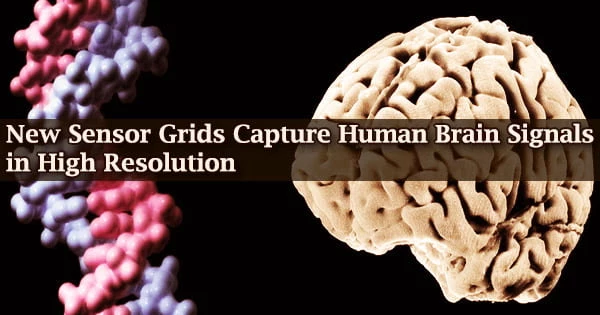Engineers, surgeons, and medical researchers have released data from both humans and rats indicating that a new array of brain sensors can record electrical signals straight from the human brain’s surface in unprecedented detail.
The new brain sensors have densely packed grids of embedded electrocorticography (ECoG) sensors, either 1,024 or 2,048. On January 19, 2022, the study was published in the journal Science Translational Medicine.
If approved for clinical usage, these tiny, malleable grids of ECoG sensors would provide surgeons with 100 times greater resolution brain-signal information straight from the surface of the brain’s cortex than what is currently accessible.
Access to this very precise view of which specific parts of the brain’s surface tissue, or cerebral cortex, are active and when could help surgeons plan procedures to remove brain tumors and treat drug-resistant epilepsy more effectively. In the long run, the researchers are developing wireless versions of these high-resolution ECoG grids that might be utilized for up to 30 days of brain monitoring for persons with intractable epilepsy.
The technology could also be used to improve the quality of life of those who suffer from paralysis or other neurodegenerative disorders that can be treated with electrical stimulation, such as Parkinson’s disease, essential tremor, and dystonia, a neurological movement disorder.
The project is led by electrical engineering professor Shadi Dayeh at the University of California San Diego Jacobs School of Engineering. The team of engineers, surgeons and medical researchers hails from UC San Diego; Massachusetts General Hospital; and Oregon Health & Science University.
Next-generation electrocorticography
Electrocorticography (ECoG), which records brain activity using grids of sensors put directly on the surface of the brain, is already widely used by surgeons doing surgeries to remove brain tumors and cure epilepsy in people who do not respond to medications or other treatments.
The authors of the Science Translational Medicine research revealed that utilizing their platinum nano-rod ECoG sensors, these functional maps may be made exceedingly exact. The researchers created functional maps of a brain boundary called the central sulcus in four distinct persons.
In a new study published in Science Translational Medicine, researchers show that grids with 1,024 or 2,048 sensors can successfully record and interpret electrical impulses directly from the surface of the brain in both humans and rats.
In comparison, most ECoG grids used in surgeries today have between 16 and 64 sensors, while custom-made research grade grids with 256 sensors are available.
The capacity to record brain impulses at such a high resolution could let surgeons remove as much of a brain tumor as possible while causing the least amount of damage to healthy brain tissue.
Higher resolution brain-signal recording capacity could increase a surgeon’s ability to precisely pinpoint the parts of the brain where epileptic seizures originate, allowing these regions to be removed without affecting surrounding brain regions that are not involved in seizure start. These high-resolution grids may help to preserve normal, functioning brain tissue in this way.
Demonstrating that ECoG grids with hundreds of sensors work successfully also offers up new prospects in neuroscience for learning more about how the human brain works. Advances in basic science could lead to better treatments based on a better knowledge of brain function.
One millimeter vs. one-centimeter spacing
The team’s ability to place individual sensors substantially closer to each other without causing excessive interference between surrounding sensors explains how they were able to record brain signals at better detail.
The team’s three-centimeter-by-three-centimeter grid with 1,024 sensors, for example, captured signals straight from the brain tissue of 19 participants who agreed to take part in the study during the “downtime” of their already scheduled brain surgeries for cancer or epilepsy.
The sensors in this grid layout are spaced one millimeter apart. ECoG grids that have previously been approved for clinical use, on the other hand, typically feature sensors spaced one centimeter apart. The new grids have 100 sensors per unit area, compared to 1 sensor per unit area in clinical grids, providing 100 times higher spatial resolution when analyzing brain signals.
Sensors made with platinum nano-rods
While utilizing platinum-based sensors to capture electrical activity from brain neurons is not new, the research team is doing so in a novel way: tiny platinum rods. The nano-rod form provides more detecting surface area than flat platinum sensors, allowing for increased sensitivity. The sensing method is based on the fact that when neurons in the brain fire, the electron count in platinum nano-rods changes.
When a neuron activates, charged ions go in and out. The voltage potential in the cerebrospinal fluid in which the neurons are bathed fluctuates due to the passage of charged ions.
Charge screening mechanisms affect the population count of electrons in platinum nano-rods as a result of variations in voltage potential in brain tissue and cerebrospinal fluid. The platinum nanorods record the firing of neurons at or near the surface of the cerebral cortex in near real-time and with high precision in this fashion.
Thin and pliable grids of sensors in various sizes
The human brain is constantly in motion. The brain, for example, moves in tandem with the pounding blood flowing through it with each heartbeat. The platinum nano-rod sensor grids are thinner and more flexible than the clinically authorized ECoG grids currently on the market. The sensor grids can move with the brain due to their thinness and flexibility, allowing for a tighter connection and better data.
The grids are also designed with little ring-shaped openings that allow cerebral spinal fluid to pass through. By allowing the sensor to readily and safely displace the fluid, these perfusion holes help to improve the contact between the sensor grid and the brain surface.
The new platinum nano-rod brain sensor grids are ten micrometers thick, or one-tenth the thickness of a human hair, and 100 times thinner than the clinically approved ECoG grids, which are one millimeter thick. The nano-rods are embedded in parylene, a translucent, soft, and flexible biocompatible substance that comes into direct touch with the brain’s surface.
The electrical signals go from the brain to the exposed surfaces of the platinum nano-rods recessed within the parylene via the cerebrospinal fluid. This design creates a sensor grid that connects to the brain’s surface in a near and steady manner, boosting signal quality.
The manufacturing procedure also allows for a wide range of sizes and shapes, which offers up new options for cortical coverage that is more tailored. Collecting data from many areas of the brain at the same time could help researchers learn more about the brain’s secrets.
The team has included design modifications oriented exclusively for clinical application thanks to tight collaboration between engineers led by electrical engineering professor Dayeh at UC San Diego and clinicians lead by neurosurgeon Ahmed Raslan at Oregon Health & Science University.
Customized sensor grids, for example, can be manufactured with unique perforations that allow surgeons to precisely insert probes and deliver electrical stimulation directly to brain tissue at specified areas.
Precision Neurotek Inc. was created by Dayeh, Raslan, and co-first author Youngbin Tchoe with the purpose of having higher-resolution ECoG grids approved for clinical usage.
More precise functional mapping
One of the difficulties in eliminating brain tumors is that the tumor causes changes in the brain, such as changing which parts of the brain are involved in which processes. These alterations need the creation of a personalized map of the patient’s brain “functional maps” by the surgical team in order to determine where to cut and where not to cut while removing as much of the tumor as possible.
The authors of the Science Translational Medicine research revealed that utilizing their platinum nano-rod ECoG sensors, these functional maps may be made exceedingly exact. The researchers created functional maps of a brain boundary called the central sulcus in four distinct persons.
The central sulcus separates the somatomotor and somatosensory cortex in the brain. The researchers implanted platinum nano-rod grids on the surfaces of these four people’s brains and asked them to perform a variety of tasks, including hand grabbing.
The researchers were able to rebuild the actual position of this crucial landmark in the brain, as well as the neural correlates in the brain that corresponds to finger sensation and hand grabbing, using this knowledge.
The platinum nano-rod grids’ results matched those of lower-resolution ECoG grids that have already been approved for clinical use, but with more accuracy about where this important functional boundary between the somatomotor and somatosensory cortex sits.
The newly defined curvilinear functional boundary, which is unique to each patient’s brain, outperforms the commonly extrapolated and linear boundaries derived from today’s one-centimeter-spaced clinical grids.
Neuroscience insights
The grids’ relevance in providing new routes in fundamental brain research is also demonstrated by some of the team’s freshly released data from experiments in rats. The researchers in the Science Translational Medicine study, for example, claim to have made the first mapping of a cortical column in a rat using brain-surface recordings.
Previously, cortical column mapping required simply the insertion of a single needle on the brain’s surface, followed by successive electrical stimulation and needle movement over the surface.
The fact that the platinum nano-rod grids provide high-resolution data in both time and space opens up a slew of new options for learning more about how the brain works in general.
Another discovery made possible by the new grids is the simultaneous detection of short and local as well as long and broad range brain waves linked with brain function. This high-resolution, time-varying (dynamic) picture of brain activity was captured in numerous additional movies that accompanied the Science Translational Medicine study and was used to interpret hand motion in novel ways using brain wave patterns.
Next steps
The team is working on a number of projects at the same time to progress these grids to the point where they can be approved for short, medium, and long-term use. The team, lead by UC San Diego electrical engineering professor Shadi Dayeh, was recently awarded a $12.25 million NIH grant to further improve the sensing system to the point where a clinical study for persons with treatment-resistant epilepsy will be conducted. This grant also funds efforts to make the system wireless, which would be important for medium and longer term use.
















